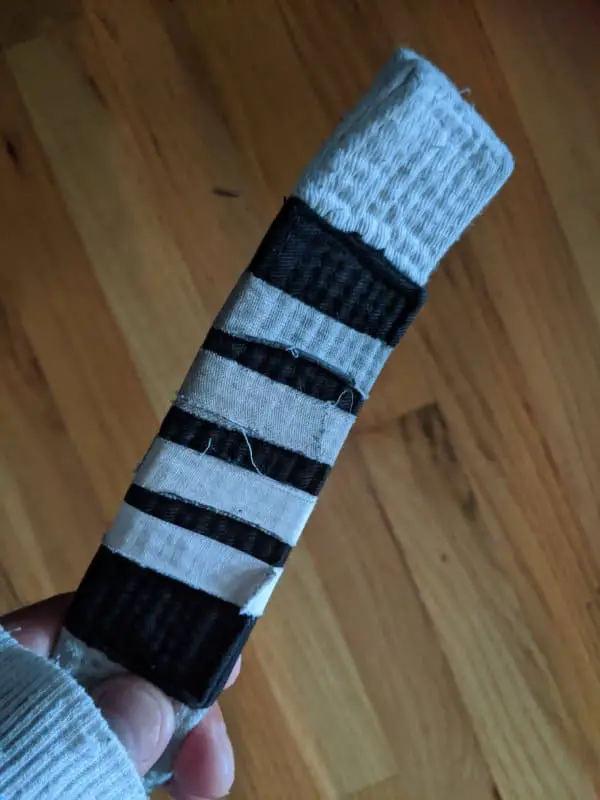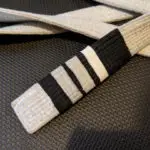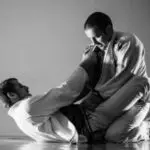You just got your third stripe and your eyes are already locked on getting that fourth stripe. It was tough work getting out of the second stripe, how much more can you give to get that fourth stripe quicker? In this article I will talk about the average time it takes to get the fourth stripe, requirements, and expectations.
It can take 6-12 months after receiving your third stripe to obtain your fourth stripe on your white belt. The requirements for the fourth stripe come down to age, ability, time invested, and instructor’s discretion. Refining escapes and defense will build confidence to attempt more submission and try new techniques that will progress you to the next level.

How Long Does It Take To Get Your Fourth Stripe?
On average it can take 1.5 to 2.5 years (18-30 months) from when you started BJJ before you receive your fourth white belt stripe. Instructors have different requirements for giving out stripes, if they use the stripe system, as stripes are not required by the IBJJF belt promotions.
Requirements
Brazilian Jiu-Jitsu instructors will have different expectations for their students to receive their fourth stripe depending on the student’s age, ability, skill, experience, time invested, or a combination of all.
Be sure to check my articles out on the first, second, and third stripe requirements to know what it takes to get here!
Age
Older students are not expected to perform at the same pacing as someone in their 20’s or 30’s while someone in their 20’s doesn’t have to be at the ADCC level to progress.
Knowledge/Ability
Instructors will recognize the ability and knowledge the student has acquired during their 3rd stripe to determine when the fourth stripe is awarded.
The difference between a three-stripe and a four-stripe may not be notable on the mats; however, many 4 stripes will have a better understanding of the fundamentals and basic techniques than a three-stripe.
Details in a technique such as knowing where to grip and apply pressure may be greater; this is noticed when doing a flow roll where athletic ability is taken out.
Time
Some gyms will use time on the mat to determine a student’s eligibility for their fourth stripe. This means a student must come to a certain amount of classes or come to class regularly for some time.
You can expect to get your fourth stripe in 1.5 – 2 years from when you started BJJ if you’re coming to class three times a week and time is a determining factor for the fourth stripe.
What Techniques Do You Need To Know?
A four stripe white belt will have the basic understandings of escapes and defense; additionally, they will start to have the confidence needed to attempt submissions they may have not in the past as they can recover from failed attempts easier.
Techniques that are typically required for a four stripe white-belt to know are:
- Trap and roll escape
- Elbow/knee escapes
- Bridging and shrimping escapes
- Positional control in guard, side control, knee-on-belly, north-south, mount, back mount
- Transitions positions: progressing from side-control to mount, attacking the back, etc…
- Americana/Armlock/Armbar/Kimura
- Rear naked choke/Bow n’ arrow/Loop choke/Triangle choke
- Sweeps from multiple positions: Elevator sweep, double ankle sweep, lumberjack sweep, tripod, etc…
- Pulling guard
- Neck and arm defense
- Framing, under hooks, and posture
It’s important to note that you’re probably not going to have each of these techniques perfected. Small details may be missing from each one or you’ll need a refresher on the technique to remind you of the finer details that will make them more successful.
Need a refresher in the basic positions in BJJ and the underlying fundamentals? Check out my two articles that go in-depth with them.
Do You Need To Have 4 Stripes To Get The Next Belt?
It is not a requirement to have 4 stripes to receive the next belt in BJJ; however, many instructors will have their students go through the process of obtaining 4 stirpes before promoting them to the next belt if they use the stripe system.
The stripe system is not used by all instructors as it is not a requirement from the IBJJF. The IBJJF does set out a general system in which four stripes can be added to a belt before the student may be considered for promotion.
Read my article about stripes if you want to learn more about the stripe system!
I have seen multiple people get two stripes at one time and I’ve seen a person go from 3 stripes to a blue belt. It all depends on the instructor and their requirements for the student to progress in the belt system.
The main lesson here, to not put so much weight into your stripes, instead, focus on improving your skills. You may be so focused on getting your fourth stripe when in reality your hard work is leading you to a belt promotion.
Or maybe, you are a 2 stripe white belt and don’t understand why you’re still at two stripes. Instead of getting discouraged just keep putting in the hard work. You’ll get your third stripe eventually, maybe even a fourth stripe instead!
What Separates A Four Stripe White Belt And A Blue Belt?
The difference between a four stripe white belt and a newer blue belt comes down to the instructor’s requirements and the student’s ability and time training; along with their background in grappling and athletics.
If you took 10 four stripe white belts and 10 various blue belts (let’s say <1 year into their blue belt) from various gyms, removed their belts, and had instructors try to pick out who were the whites and who were the blues, you would have mixed results.
Conclusion
The difference between a 3 stripe and a 4 stripe white belt is minimal in most cases with the main difference being time training and the refinement in details with the techniques used.
Refining the details within a technique will be the difference between failing another escape to succeeding to obtain a dominant position. With the ability to escape more successfully you’ll start to build confidence in attempting submissions you may have passed over because of the fear of ending up at the bottom.
The additional confidence will allow you to be humbled by students that have been training for less time than you. You may try a new attack or transition and be swept or advanced on by the new student; however, the difference now is that you welcome the opportunity to practice your escapes, defense, and can more often than not, reverse the position.





